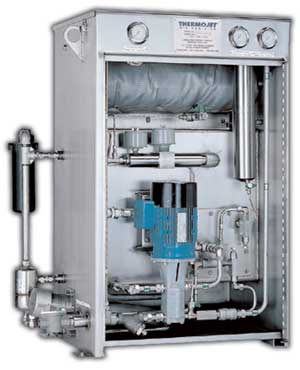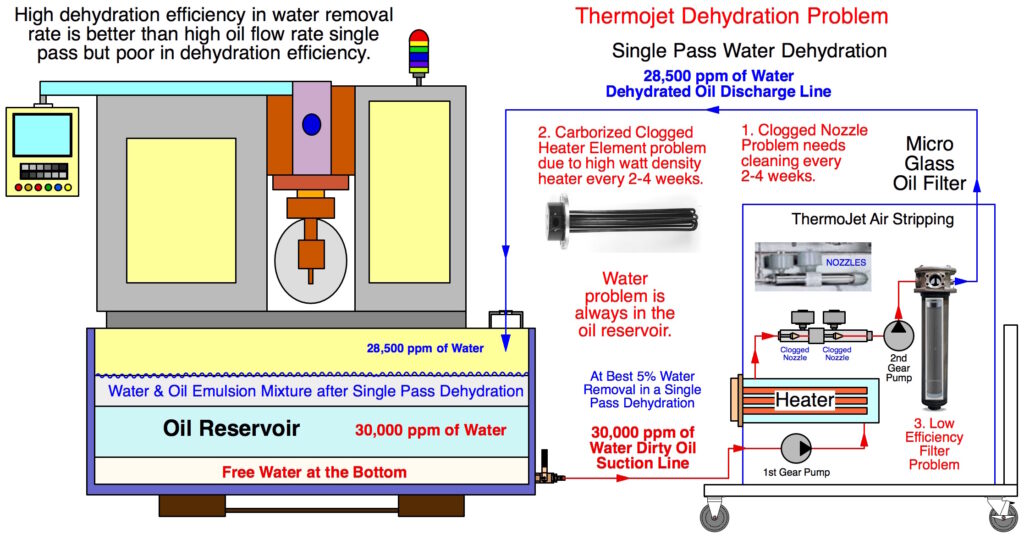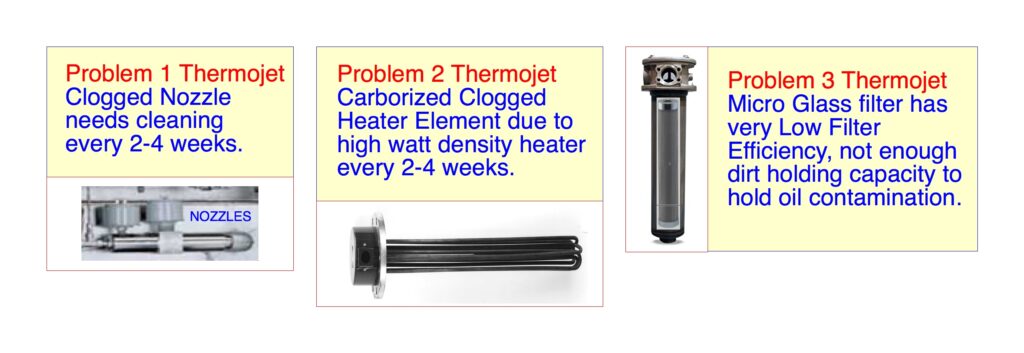2.1.3 Failure of Thermojet Dehydration

Problem of Thermojet Dehydration in Sluggish Water Dehydration
Thermojet work on principle of Atomization of oil and air as called “Air Stripping” by using tandem pump to pressurize the oil at 250 psi and heat at 165 °F to 185 °F through small Eductors. The discharged oil has pressure drop from 240 psi to 0 psi and allows water to strip out from oil into a water collector. The secondary tandem pump will pump the dehydrated oil through a 3-6 micron Micro Glass Cartridge Filter to remove solid particulate.

Micro Glass Cartridge Filter

Thermojet Unit
Disadvantages of Thermojet Dehydration
- Thermojet has electric enclosure for NEMA 7 Explosion Proof category which allows to use in Oil & Gas industries that equipment locates near by flammable gases under Class 1 Div 2. It is noticeable that Thermojet enclosure is made of 1/2″ thick aluminum casting for explosion proof application. This NEMA 7 is not required in most industries except Oil & Gas industry. This makes Thermojet overprice as compared to other dehydrators.
- Thermojet has lower dehydration capacity as compared to most vacuum distillation.
- Thermojet need to heat the oil temperature to 165 °F to 185 °F in order to weakening the water and oil molecule to strip out. 185°F Oil temperature is too high and cause oil oxidation to occur during dehydration. Dehydrated oil will become more Acidic and Deteriorated.
- Thermojet gear pump pressurizes the oil at 240 psi and drop to 0 psi after eductor to atomize the oil and water. Oil with water at 240 psi makes gear pump more excessive and shorten its pup life. It is not suitable to run Thermojet 24/7-365 Days-Non Stop without tedious maintenance.
- Thermojet uses 150 mesh or 200 micron Y-Strainer prior to gear pump which is not enough to protect pump as Y-Strainer is too small, not enough surface area protection and unable to handle High Dirt Holding Capacity. Y-Strainer will need to remove and clean on a regular basis and require more maintenance time.
- Thermojet uses 12KW heater with too high watt density that cause heater element to coked up on surface. Carbon molecule in oil breakup and adhere to heater coil surface. This requires heater to clean every 2-4 weeks of run time as well as short life heater. Thermojet Heater has to have high wattage and watt density in order to get enough heat for dehydration, thus. leads to heater maintenance problem. A good watt density for oil heating should be 8-12 watts per inch2. This will help prevent heater clogging prematurely.
- Thermojet Nozzle can easily Clog when heater is coking up and when built up dirt obstructs Nozzle tiny hole. Water dehydration will be slow or stop and pump is still running when nozzle clogged. The whole plumbing has to be taken apart in order to get to the inside and clean the clogged nozzle manually.
- Thermojet uses Cartridge Paper Filter that is made of Micro Glass Fiber coating on paper surface. The oil pressure surge can purge the filter material and easily cause Low Filtration Efficiency. This type of filter will not be able to get the ISO Code 13/10 or NAS 6 as claimed in its brochure. Micro Glass Filter also has low Dirt Hold Capacity as seen on its physical size.

Advantages and Disadvantages between Thermojet and Vacuum Distillation
- Thermojet has advantage on higher viscosity from ISO grade 220-320 but heating temperature has to be as high as 175 °F. While Vacuum Distillation has a hard time handle oil viscosity higher than ISO 150. For ISO 220 viscosity grade Vacuum Distillation will drop their efficiency by 50% -75%.
- Vacuum Distillation is much more efficient than Thermojet when uses with oil with less ISO 150 viscosity grade.
- Both Thermojet and Vacuum Distillation has the high maintenance problem. Thermojet requires labor intensive to clean up the components while Vacuum Distillation requires expensive parts such as vacuum pump and condenser replacement.

OilPure VJ Vacuum Jet Dehydration is capable of removing both Dissolved Water and Free Water from oil at the same time from VJ unit. 30,000 ppm of Water in the oil entering from suction line of VJ unit will be taken down to 50-100 ppm and discharge out from VJ unit back to oil reservoir.
VJ Vacuum Jet Dehydration contains a Built-in Dehydrating Tank that allows the wet oil to perform a Multiple Pass Dehydration until water content drops down to 50-100 ppm and controlled by MS1 Moisture Sensor. Then VJ pump will discharge the Dried Oil back to equipment oil reservoir and ready for the next dehydration cycle. With this multiple Pass Dehydration Free Water from bottom of oil oil reservoir will not have a chance to end up mixing with upper oil from dehydrator. Water will eventually diminish from oil reservoir.
Vacuum Jet Dehydration can read and display water content in % aW (Saturated Point) and ppm on PLC display. These water information can be transmitted with Remote Monitoring System through cellular phone App in both IOS iPhone and Android. VJ unit can also perform a Remote Control Operation which can be accessed from outside by smart phone App. The display on smart phone will be as if you stand in front of the VJ PLC display and operate the VJ unit remotely. These communication features can not be found in any other dehydration equipment in north America or Europe or Asia.

The above information is based on our experiences with users and their comments who wishes the manufacturer can improve their products. Please review with good discretion.
- Contact Information – OilPure Technologies, Inc.:
- P.O. Box 483976 • Kansas City • Missouri 64148 • USA • SKYPE ID: oilpure • LINE ID: oilpure
- Tel: 913-906-0400 • Mobile: 913-522-0272 • Fax: 913-906-9815 • WhatsApp: 1-913-522-0272
© Copyright, August , 2021
Document and information in this website is a proprietary information belonging to OilPure and is not allowed to reveal to public without OilPure consent.






















